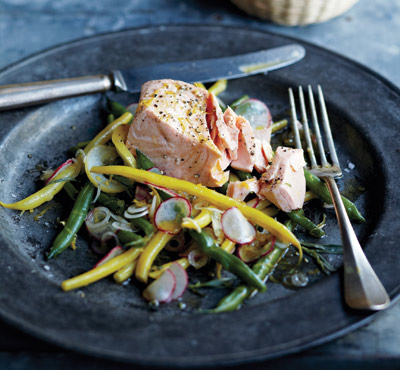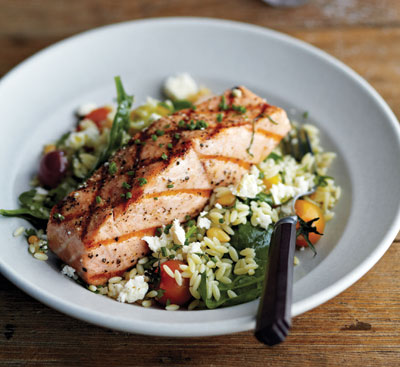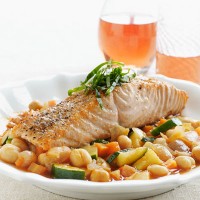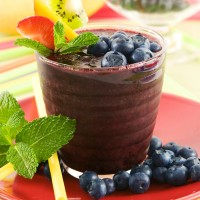Curtis Stone Is Wild About Salmon!
The wait is over. Wild salmon season kicks off in May, as prized kings and sockeyes make their way into fish markets and restaurants nationwide. Fresh from the icy waters of Alaska, wild Pacific salmon boasts five varietals — king, sockeye, coho, keta, pink — each with a distinctive flavor profile. With its versatility, ease of cooking, and healthy fats, salmon is one of America’s top go-to seafood choices. I buy wild salmon whenever I can, preferring its flavor to the farm-raised kind.
Making great salmon begins at your local fish market or grocery. Use your senses. Fresh fish should never smell fishy — more like the ocean. When buying whole salmon, make sure the eyes are bright, gills red, and skin vibrant and shiny. Look for fillets that are moist, not dried out or discolored, and of even thickness so they cook evenly and consistently.
Overcooking is the most common mistake with fish. Cook salmon until it is still rosy in the center, then let it rest uncovered for 3 minutes. If preparing with skin on, make sure you get it nice and crispy; otherwise, the result is rubbery and inedible.
Poached Salmon with Green and Yellow Bean Salad grew out of a trip to the Hollywood Farmers’ Market, where I couldn’t resist the yellow wax beans and red radishes. My wife, Lindsay, and I love the Grilled Salmon with Orzo, Feta, and Red Wine Vinaigrette as a main-course salad any day of the week and for any occasion.

Poached Salmon with Green and Yellow Bean Salad
(Makes 4 servings)
4 sprigs fresh tarragon
2 lemons
4 shallots, peeled, thinly sliced
4 5-ounce skinless salmon fillets
8 ounces thin green beans, trimmed
8 ounces thin yellow wax beans, trimmed
2 tablespoons butter
2 radishes, sliced into paper-thin rounds
Remove leaves from tarragon; reserve stems. Coarsely chop enough leaves to make 2 teaspoons. Slice 1 lemon into thin rounds. In 12-inch fry pan, combine lemon rounds, tarragon stems, and one-third of shallots and add enough cold water to come two-thirds of way up sides. Cover and bring water to simmer over medium-high heat. Season salmon with salt and pepper to taste. Lay fillets in pan and add hot water if needed to submerge them completely. Cover, reduce heat to low, and cook salmon, without simmering, for about 7 minutes, or until opaque with rosy center. Using slotted spatula, transfer salmon fillets to 4 plates.
Meanwhile, in another 12-inch fry pan, combine beans with ½ cup water. Cover and steam over medium-high heat for about 3 minutes, or until crisp-tender. Uncover and cook for 30 seconds, or until liquid is reduced by half. Remove pan from heat. Add butter, remaining shallots, chopped tarragon, and zest and juice from remaining lemon and toss until butter melts. Season with salt and pepper. Divide beans among the plates. Garnish with radishes and serve.
Make-Ahead: For chilled poached salmon, salmon can be poached 4 hours ahead, cooled, covered, and refrigerated.
Per serving
Calories: 292
Total Fat: 14 g
Saturated Fat: 5 g
Sodium: 165 mg
Carbohydrate: 9 g
Fiber: 3 g
Protein: 32 g
Diabetic Exchanges: 5 meat, 2 fat, 1 vegetable

Grilled Salmon with Orzo, Feta, and Red Wine Vinaigrette
(Makes 4 servings)
1 ½ cups orzo
3 tablespoons red wine vinegar
3 tablespoons finely chopped shallots
2 garlic cloves, finely chopped
⅓ cup extra-virgin olive oil
2 ounces fresh baby spinach (about 3 cups not packed)
1 ½ cups grape tomatoes, halved
½ cup pine nuts, toasted
¼ cup thinly sliced fresh basil leaves
4 5-ounce skinless salmon fillets
Olive oil, for coating fish
1 cup crumbled feta cheese (4 ounces)
2 tablespoons chopped fresh chives, for garnish
Prepare an outdoor grill for medium-high cooking over direct heat.
To make orzo salad: Bring large saucepan of salted water to boil over high heat. Add orzo and cook, stirring often, for about 8 minutes, or until just tender. Drain orzo in sieve and set aside. In medium bowl, whisk vinegar, shallots, and garlic together. Gradually whisk in olive oil. Season to taste with salt and pepper. In large bowl, toss warm orzo, spinach, tomatoes, pine nuts, and basil with vinaigrette. Season to taste with salt and pepper. Set aside at room temperature.
To cook salmon: Coat salmon with olive oil and season with salt and pepper to taste. Oil cooking grate. Place salmon on grill with top-right corner of each fillet facing 2 o’clock position and cook for 4 minutes without moving salmon. (This will help give salmon a good sear of nice grill marks and help it release from grate.) Using thin metal spatula, starting at corner of each fillet nearest you, flip fillets over. Grill for about 2 minutes or until fish is opaque with slightly rosy center when flaked in thickest part with tip of small knife. Remove from grill.
Mound salad in center of large serving platter or four dinner plates. Sprinkle with feta. Top with salmon, sprinkle with chives, and serve.
Make-Ahead: The orzo can be cooked up to 1 day ahead, cooled, covered, and refrigerated.
Per serving
Calories: 615
Total Fat: 38 g
Saturated Fat: 8 g
Sodium: 406 mg
Carbohydrate: 30 g
Fiber: 5 g
Protein: 40 g
Diabetic Exchanges: 1 ½ starch,
1 ½ vegetable, 5 lean meat, and 4 fat
This article is featured in the May/June 2017 issue of The Saturday Evening Post. Subscribe to the magazine for more art, inspiring stories, fiction, humor, and features from our archives.
Excerpted from What’s For Dinner? by Curtis Stone. Copyright © 2013 By Curtis Stone. Excerpted by permission of Ballantine Books, a division of Random House, LLC. All rights reserved. No part of this excerpt my be reproduced or reprinted without permission in writing from the publisher. Photo by Quentin Bacon.
12 Foods That Are Part of a Healthy Lifestyle
Some of your favorite foods can help you stay young and healthy. Preventive nutrients in the following ingredients can lower your blood pressure and decrease your risk of heart attack and diabetes. Ellie Krieger, registered dietician and host of Food Network’s Healthy Appetite, shares two full-flavored, rejuvenating recipes.
1. Monounsaturated fats in olive oil are associated with lower rates of heart disease and colon cancer, and reduced risk of diabetes and osteoporosis.
2. Quercetin in onions is one of the most powerful flavonoids (natural plant antioxidants). Studies show it helps prevent cancer.
3. Rich in carotenoids, carrots may help lower cholesterol, regulate blood sugar levels, and protect against coronary heart disease and certain cancers.
4. An excellent source of potassium and manganese, zucchini provides your body with vitamins C, B1, and B6.
5. Several population studies associate an increased intake of garlic with a reduced risk of cancers, including stomach, colon, esophagus, pancreas, and breast.
6. Processing makes the cancer-fighting compounds in tomato paste more available to your body because heat breaks down the plant’s cell walls.
7. The type of soluble, cholesterol-lowering fiber found in chickpeas is not only heart-healthy, but helps stabilize blood sugars—particularly important for people living with diabetes.
8. Fresh basil boasts a healthy dose of blood-clotting vitamin K, and its oils and extracts are said to possess antibacterial and antioxidant properties.
9. Omega-3 fatty acids found in salmon promote heart, skin, and joint health. A study in the British Journal of Ophthalmology suggests omega-3s could also protect against age-related macular degeneration (AMD).
10. Data from a study published in Diabetes Care reported that a dietary pattern incorporating more low-fat dairy products may lower the risk of type 2 diabetes in middle-aged or older women.
11. According to a USDA Human Nutrition Research Center on Aging in Boston report, blueberries may improve motor skills and reverse the short-term memory loss that comes with aging.
12. A limited study at the University of Memphis Exercise and Sports Nutrition Laboratory found honey to be one of the most effective forms of carbohydrate gels to ingest prior to exercise, also functioning well in post-workout recuperation.
Salmon with Chickpea Ragu

(Makes 4 servings)
- 1 tablespoon olive oil
- 1 small onion, chopped
- 1 large carrot, peeled and diced
- 1 large zucchini, diced
- 2 cloves garlic, minced
- 2 tablespoons tomato paste
- 4 cups low-sodium chicken broth
- 1 (15.5-ounce) can low-sodium chickpeas, drained and rinsed
- 1 cup basil leaves, sliced into ribbons, plus more for garnish
- ½ teaspoon salt (optional)
- ½ teaspoon freshly ground black pepper
- 4 (6-ounce) skinless salmon fillets
Heat oil in large skillet over medium-high heat. Add onion and cook until soft, about 3 minutes. Add carrot, zucchini, and garlic and cook, stirring, until carrots are firm-tender, about 4 to 5 minutes. Add tomato paste and stir. Add chicken broth and chickpeas and bring to boil. Reduce heat to low and cook, covered, until liquid thickens, about 10 minutes. Remove skillet from heat, add 1 cup basil and ¼ teaspoon each of salt and pepper. Stir and cover to keep warm.
To cook salmon: preheat broiler. Season with remaining salt and pepper. Broil fillets for 8 to 10 minutes per inch thickness, turning once. Serve with 1 ½ cups chickpea ragu in shallow bowl. Garnish with basil.
Per serving: 1 salmon fillet and 1 1/2 cups chickpea ragu
calories: 460
fat: 17 g (saturated: 2.5 g; monounsaturated: 7 g; polyunsaturated: 5 g)
protein: 46 g
carbohydrate: 30 g
fiber: 6 g
cholesterol: 95 mg
sodium: 550 mg
Ellie’s Blueberry Blast Smoothie

(Makes 1 smoothie)
- ½ cup nonfat milk
- ½ cup plain nonfat yogurt
- 1 cup frozen unsweetened blueberries
- 1 teaspoon honey
Put all ingredients into blender and process until smooth.
Per serving: 1 smoothie
calories: 195
fat: 1 g (saturated: 0 g; monounsaturated: 0 g; polyunsaturated: 0 g)
protein: 10g
carbohydrate: 40 g
fiber: 4 g
cholesterol: 5 mg
sodium: 134 mg
Spice Things Up!
Krieger says spices such as turmeric (found in curry) and ginger provide anti-inflammatory effects—an observation especially important for anyone suffering from rheumatoid arthritis or inflammation-related ailments.